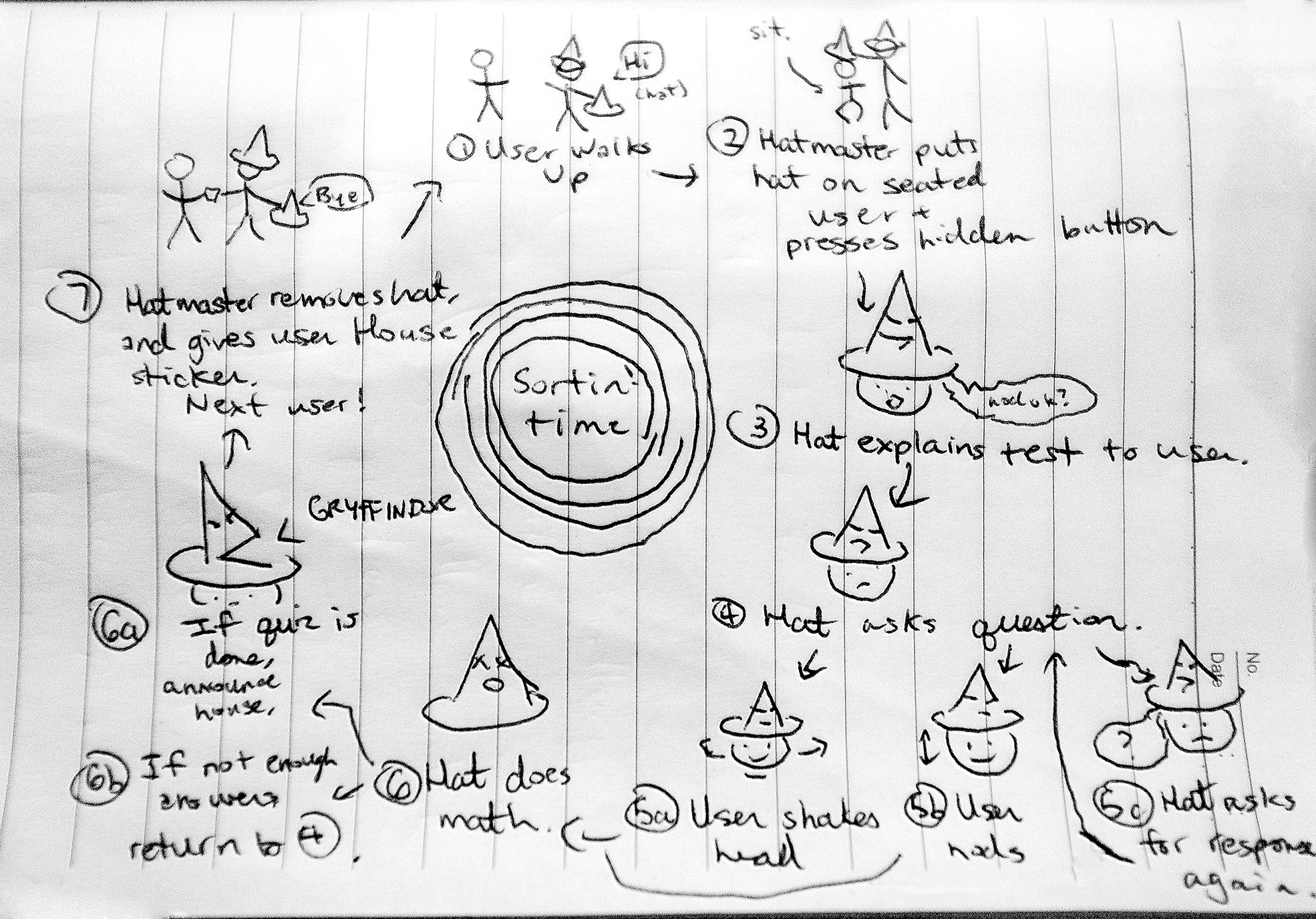Playtest and Planning
Last Thursday, we did some play tests of prototypes for our Physical Computing final. I didn’t think I would learn that much, but play tests will often surprise you. I constructed a prototype by wetfolding some Trader Joe’s paper bags– it looked rather good in my opinion. I also made myself a hat; as the McGonagall of my demo I should be similarly outfitted!

I also wrote a script out, and recorded some lines with Nate. There were around 15 questions to ask, and preamble to go with them as well. I then created a JavaScript soundboard for my questions– it’s a hi-tech lo-fi prototype.

The Play test
I had some questions in mind going into the play test:
Does this take too long? Was there too many questions? Do you know to just put it on? Do you find nodding and shaking your head intuitive? Are you mad if you get a result you don’t agree with? Did you want to talk about yourself in a freeform manner? Would you enjoy watching other people get sorted? Would you get bored if they have the same questions? Do you want your house announced to the world, like the books and movies, or should it be a private experience?
These questions and more were answered by my helpful play testers.

Look at how cute this is! The playtesters are cute and smart as well, providing me with some helpful feedback:

From the play test I learned the following:
- Contrary to my assumptions, people really enjoyed answering yes or no questions about themselves and didnt find it tedious. In fact, most people felt they could’ve answered more than the seven or so questions I gave them.
- Nodding and head shaking were intuitive, for the most part– one person shook their head in an unexpected way. Since the hat will be supervised the whole time, I can probably just monitor and correct people who do it wrong, but I should be cognizant of this and adjust the accelerator as necessary.
- Speech recognition would be nice, but holy cow– it gets loud when the room is full of people talking. My tiny phone speaker had to be held up to ears just to be heard. Speech recognition for the Arduino is consequentially unfeasible, and, since people liked the nodding, not necessary.
- Also, my original concept that the hat would accept freeform responses would be scrapped.
- Lots of people don’t know Harry Potter, or have forgotten the houses (the remaining people remember, and are very opinionated about them!) I should put up flags or posters to remind people of the idea, and perhaps integrate it into the hat. Maybe the hat could the song from the books, but that might take a long time.
- People wanted to watch others get sorted, but didn’t want others to hear their questions and responses. They wanted some privacy. This takes care of my concerns about it being boring to watch repeated questions, but it might be boring to watch the silent questioning.
- They totally wanted the houses to be loudly announced. They also wanted cloaks. If I go all in on theatricality, they may forgive other flaws of the hat.
Planning
My description from the last blog post hardly needed updating:
The Sorting Hat is a loving recreation of a magical object in the world of the Harry Potter series. In the books, the hat reads your mind to determine which of four school houses you have the most affinity for. In real life, we are unable to read minds, so the Sorting Hat asks you a series of questions and determines your house based on your responses. Physically, it is an anthropomorphic hat that beckons you to put it on. Once on your head, it will guide you through a series of yes or no questions to which you will respond with nods or head shakes. The hat will then decide your house, which it will announce loudly, and you can enjoy a sense of belonging and delight at this talking hat’s decisions.
But my timeline certainly needed some new information and simplification.

I also created a system diagram of sorts– I’m calling it a hat-user story diagram.

With this information in mind, I created an initial bill of materials. It’s all a lot pricier than I had anticipated, and this is without the speaker / voice recognition that I had originally planned on. The servos I’ll probably be able to borrow for free, but maybe I should just have servos on hand. You’ll never know when they’ll come in handy.

Subscribe via RSS
